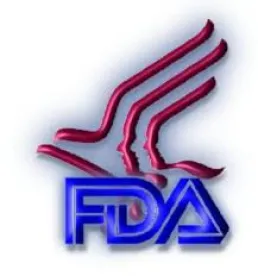On May 10, the Food and Drug Administration (FDA) issued a Federal Register notice requesting comments relating to the development of a user fee program for biosimilar and interchangeablebiological product applications submitted under section 351(k) of the Public Health Service Act (PHSA).1 FDA is requesting comments relating to FDA’s key principles for development of a 351(k)user fee program and FDA’s proposed 351(k) user fee goals for this program. 2 FDA is accepting comments on the 351(k) user fee program through June 9, 2011.3
Background
The Patient Protection and Affordable Care Act (PPACA)4 amended the PHSA to create a regulatory approval pathway for abbreviated biologic applications.5 In doing so, PPACA also amended theprescription drug user fee provisions under section 735 of the Federal Food, Drug, and Cosmetic Act6 (FFDCA) to include 351(k) applications. Under PPACA, the user fee for a Biologic License Application (BLA) is the same regardless of whether the application is submitted under the new 351(k) approval pathway or the preexisting 351(a) approval pathway through September 2012.7 However, PPACA directs FDA to develop recommendations for a user fee program specifically for 351(k) applications for Fiscal Years 2013–2017.
FDA’s Key Principles
FDA intends to use a set of key principles to support the development of the 351(k) user fees. According to the May 10 Federal Register notice, FDA identified the following four proposed key principles as the basis for the 351(k) user fee program:8
1. FDA needs sufficient resources to review 351(k) applications and prevent unnecessary delays inthe development and approval of these products.
2. At least for the initial time period, 351(k) user fees should remain comparable to 351(a) user fees because determining whether 351(k) products are biosimilar or interchangeable will be as challenging, comparably complex, technically demanding, and resource-intensive as a review of a proposed 351(a) application.
3. Given that the 351(k) approval pathway for biosimilar and interchangeable products is new, FDAservices are most critical during the investigational stage prior to submission of a marketing application. Therefore, the 351(k) user fee program should provide funding to support activities that occur early in the biosimilar and interchangeable product development cycle.
4. Applications submitted under either section 351(a) or 351(k) need adequate resources to ensure the best health outcomes for U.S. patients and fairness to all industry sponsors. The same expert scientific teams that conduct FDA’s review of 351(a) applications will typically be involved in the review of 351(k) applications. The 351(k) user fee program should therefore ensure there are adequate resources for the review of 351(k) applications so that critical resources for 351(a) review are not redirected from innovator drug review to biosimilar products.
Based on these four key principles, FDA developed the proposed structure of the 351(k) user fee program.
FDA’s Proposed 351(k) User Fee Program
FDA believes that the 351(k) proposed user fee program would ensure funding for the development of the 351(k) application review process while charging applicants no more than for a review of a 351(a) marketing application. However, because FDA is receiving a lot of requests from sponsors, in the early stages of development, for consultation, FDA proposes modifying the 351(k) user fee program to “shift payment for FDA review to the earlier stage of development where FDA activities currently are in greatest demand.”9
Based on the key principles above, FDA proposed the following 351(k) user fee program:10
Premarket Fees
-
A “Biosimilar Product Development fee, paid upon submission of an investigational new drug application [(IND)] and annually thereafter for a biosimilar or interchangeable product underactive development that is intended for submission in a single 351(k) marketing application.”11 The estimated Biosimilar Product Development fee for FY 2013 is $150,000.12
-
A “351(k) Marketing Application fee, paid for each submitted 351(k) marketing application. This fee would be set equal to a 351(a) marketing application fee, less the sum of all of the reviously paid annual Biosimilar Product Development fees associated with the biosimilar product that is the subject of the 351(k) application.”13 The 351(k) Marketing Application fee will be equal to that of a 351(a) submission.14
Marketed Products Fees
1. An “Establishment fee, paid annually for each biosimilar and interchangeable biological product establishment listed in an approved 351(k) application. The establishment fee is assessed for each biosimilar and interchangeable biological product that is assessed a product fee—unless the establishment listed in the application does not manufacture the product during the FY.”15 The Establishment fee will be equal to the 351(a) PDUFA fee.16
2. A “Product fee, paid annually for each eligible approved biosimilar and interchangeable biological product.”17 The Product fee will be equal to the 351(a) Prescription Drug User Fee Act (PDUFA) fee.18
One thing that sponsors should keep in mind when reviewing the proposed user fee program is the fact that under this proposed program, sponsors would be required to declare whether their actions are to support a 351(k) or 351(a) marketing application upon IND submission. Therefore, sponsors will need to consider the clinical, exclusivity, reimbursement and substitutability, and intellectual property challenge ramifications at this early stage.
Performance Goals
In the May 10 Federal Register notice, FDA proposed performance goals for 351(k) applications submitted 10 or more years after the date of first licensure of the reference product and asked for public input on performance goals of 351(k) applications submitted less than 10 years since the date of first licensure of the reference product.19 FDA’s proposed performance goals for 351(k) applications submitted 10 years after the date of first licensure are as follows:20
| Applications Requesting a Biosimilarity Determination | Applications Requesting an Interchangeability Determination | |
| FY2013 |
Review and act on 50% of:
|
Review and act on 50% of:
|
| FY2014 |
Review and act on 60% of:
|
Review and act on 60% of:
|
| FY2015 |
Review and act on 60% of:
|
Review and act on 70% of:
|
| FY2016 |
Review and act on 60% of:
|
Review and act on 80% of:
|
| FY2017 |
Review and act on 90% of:
|
Review and act on 90% of:
|
For 351(k) applications submitted less than 10 years from the date of first licensure, FDA requests comments on the following questions:21
1. What factors should FDA consider in determining appropriate performance goals for 351(k) applications that are filed earlier than two years prior to the date on which a 351(k) application would be eligible for approval (i.e., 12 years after the date of first licensure of the reference product)?
2. How should the performance goals take into account readiness for inspection?
3. What other factors relating to the unique characteristics of the 351(k) approval pathway should FDA consider when setting performance goals for 351(k) applications?
Areas for Potential Comment
FDA’s Key Principles
Two recurring themes are very evident in FDA’s proposed key principles: 1) FDA believes it needs more resources in order to proceed with a 351(k) review program and 2) FDA believes the 351(k)review process will be challenging and complex. While most would agree with the first theme, FDA’s actions surrounding the challenging and complex review process could, and should, be major areas of discussion within industry.
351(k) Review Process
FDA’s second key principle states that the 351(k) review process will be as challenging, comparably complex, technically demanding, and resource-intensive as a review of a proposed 351(a) application. FDA is signaling that the 351(k) process will be more challenging than the abbreviated new drug application (ANDA) or 505(b)(2) review process. This principle provides industry with an opportunity to provide FDA with suggestions on the scope of review of the 351(k) application.
Shifting the User Fees to the Investigational Stage
FDA’s third key principle states that FDA’s services for the 351(k) review process are “most critical” during the investigational stage prior to submission of a marketing application. FDA uses this logic to shift the PDUFA fees to the earlier stages of development. However, FDA does not set any PDUFA goals relating to meetings or consultation during the investigational stage. Will industry have more frequent or in-depth access to FDA during the investigational stage by paying user fees earlier?
In addition, in its discussion of shifting user fees forward, FDA mentions FDA’s cost associated with the development of the 351(k) review program. However, FDA ignores the fact that shifting the costs forward will increase the burden on 351(k) sponsors. Many startup biologic companies will be unable to pay $150,000 a year. In addition, many investors will want further proof that a compound has serious potential to move forward in development before they will be willing to cover potentially multiple $150,000 annual Product Development fees. There is also no discussion of a refund of fees if the application is withdrawn or rejected.
Integrated Teams of Reviewers
FDA’s fourth key principle states that FDA will utilize the same expert scientific teams that conduct FDA’s review of 351(a) applications to review 351(k) applications. Currently, ANDA sponsors interact with FDA’s Office of Generic Drugs (OGD), and new drug application (NDA) sponsors interact with separate review teams in the Center for Drug Evaluation and Research (CDER). However, under FDA’s fourth key principle, both 351(a) and 351(k) sponsors will interact with the same CDER/Center for Biologics Evaluation and Research (CBER) review teams.
This strategy will produce a host of new issues for sponsors. For example, the CBER review teams that review a 351(k) application may have extensive knowledge and background on specific products. Could, and should, this information, some of which may be proprietary, influence a review team’s analysis, and at what point in the review process? How will standards for the reference and follow-on products be affected? These are potential issues that are not addressed in the Federal Register but may be worth commenting on by industry and sponsors.
Biosimilar v. Interchangeability Determination Effect on User Fees and PDUFA Goals
The May 10 Federal Register notice did not provide PDUFA goals or user fee information for 351(k) applications that initially indicate a request for biosimilarity determination but later request an interchangeability determination. Some sponsors may initially start the 351(k) process with a goal of first obtaining biosimilarity. However, as clinical trials and market experience are developed in support of the 351(k) application, sponsors may be able to compile the information necessary for an interchangeability determination. Therefore, sponsors should consider submitting comments on whether a supplemental request for an interchangeability determination should be considered a supplement to an existing 351(k) application or require a new 351(k) application, and the applicable fee structure.
Summary
FDA’s proposed user fee program will have an effect on sponsors of both 351(a) and 351(k) applications. Sponsors of both applications should consider submitting comments on the principles used to establish the fees, and whether the fee structure achieves the regulatory and legislative goals of PPACA.
1. Biologics Price Competition and Innovation Act of 2009; Options for a User Fee Program for Biosimilar and Interchangeable Biological Product Applications for Fiscal Years 2013 Through 2017; Request for Comments, 76 Fed. Reg. 27,062 (May 10, 2011).
2. Id.
3. Id.
4. Patient Protection and Affordable Care Act, Pub. L. No. 111-148 (2010), as amended by the Health Care and Education Reconciliation Act of 2010, Pub. L. No. 111-152 (2010).
5. The abbreviated pathways are mechanisms for 351(k) sponsors to introduce biosimilar and interchangeable products.
6. 21 U.S.C. § 379g.
7. 76 Fed. Reg. 27,062 (May 10, 2011).
Id. at 27,063.
9. Id.
10. Id. At 27,064.
11. Id.
12. Id.
13. Id.
14. Id.
15. Id. at 27,063.
16. Id.
17. Id.
18. Id.
19. Under PPACA, a sponsor may file a 351(k) application four years after the reference product was first licensed. However, FDA may not approve a 351(k) application until 12 years after the reference product was first licensed.
20. 76 Fed. Reg. 27065.
21. Id. At 27,066.5





 />i
/>i

